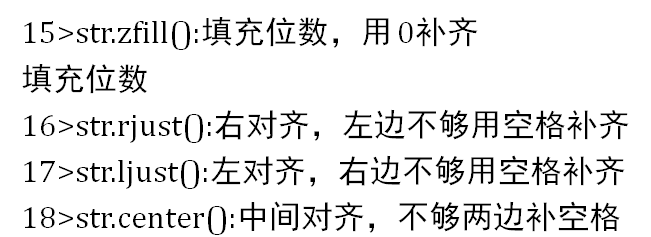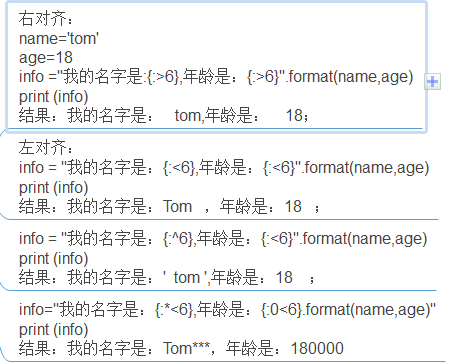python-字符串方法,格式化输出
学了这么久了,想总结一下python基础性知识,写的不好或者不对的地方,大家也可以留言让其补充、修改:
1. 字符串的定义:(ctrl+/)注释/取消注释
单引号、双引号、三引号(其中三引号也可以用来做注释)
str = "aad222"
str = 'ss22'
str = ''' ss222'''
2. 字符串拼接(+号)
print('hello'+'world') ---- helloworld
print('hello'+'3') ---- hello3
print('hello'*3) ----- hellohellohello
print('hello '*3) ---- hello hello hello
print(3,'hello') --- 3 hello
几种报错的拼接字符串:
print('hello'+3) --- 报错。类型不一致。和前面的保持一致(typeerror:must be str,not int)
print(3+'hello') --- 报错,类型不一致。和前面保持一致(typeerror:unsupported operand type(s) for +:'int' and 'str')
3.序列操作
序列定义:一个序列,若干个元素组成;一般下标从0开始
常用操作:
a.获取元素
str[10]/str[len(str)-1]/str[-1]
b.求元素个数
len(str)
c. 获取某元素的下标
str.index('b')
d.切片操作
string[start:end]:从start开始,到end结束,但不包含end
string[start:]:从start开始,到字符串结束
string[:end]:从第一个字符开始,到end位置结束,但不包括end
string[start:end:步长]:步长默认是1
字符串倒序:string[::-1]
正下表:从左向右:0,1,2,3,4
负下标:从右向左:-1,-2,-3,-4
in : 成员运算符 - 如果字符串中包含给定的字符返回 True
可以使用find方法,不等于-1则表示找到
例如: str = 'hello'
'h’ in str ----- True
not in : 成员运算符 - 如果字符串中不包含给定的字符返回 True
例如: str = 'hello'
'a' not in str -- True
r/R : 原始字符串 - 原始字符串:所有的字符串都是直接按照字面的意思来使用,没有转义特殊或不能打印的字符。 原始字符串除在字符串的第一个引号前 加上字母"r"(可以大小写)以外,与普通字符串有着几乎完全相同的语法。
例如: open(r"d:\project\aa.txt")
% : 格式化字符串
4.Python转义字符
| \(在行尾时) | 续行符 |
| \\ | 反斜杠符号 |
| \' | 单引号 |
| \" | 双引号 |
| \a | 响铃 |
| \b | 退格(Backspace) |
| \e | 转义 |
| \000 | 空 |
| \n | 换行 |
| \v | 纵向制表符 |
| \t | 横向制表符 |
| \r | 回车 |
| \f | 换页 |
| \oyy | 八进制数,yy代表的字符,例如:\o12代表换行 |
| \xyy | 十六进制数,yy代表的字符,例如:\x0a代表换行 |
| \other | 其它的字符以普通格式输出 |
5.字符串常用的方法
1> str.count():计算字符串中包含多少个指定的子字符串
info = "abcdefa"
print (info.count('a')) ---- 2
2> str.startswith():检查字符串是否以指定的字符串开头
info = "this is tom"
print (info.startswith("this")) --- True
3> str.endswith() :检查字符串是否以指定的字符串结尾
info = "this is tom"
print (info.endswith("tom")) -- True
4> str.find() :返回指定的子字符串在字符串中出现的位置
"123456789".find("456") ---- 3
"ok,good,name".find(',') ---- 2 (有多个则返回第一个)
“ok,good,name”.find('o',3) -- 4(指定位置开始找,正序找)
“ok,good,name”.find('o',-1) -- 0(指定位置开始查找:倒序只找最后一个元素)
5> str.isalpha() :检查字符串中是否都是字母
"abc1".isaplha() -- False
6> str.isdigit() :检查字符串中是否都是数字
"123123",isdigit() --- True
7> str.join():将sequence序列类型的参数的元素字符串合并(连接到一个字符串)
print("##".join(['i','like','play','football!'])) -- i##like##play##football
print("##".join(('i','like','play','football!'))) -- i##like##play##football
8> str.split():将字符串分割为几个子字符串,参数为分隔符,返回list列表
被分割的切点会被拿掉
info = 'name is tom '
print(info.split(' ')) ---- ['name','is','tom','']
9> str.lower() :将字符串里面如果有大写字母的全部转为小写字母
10> str.opper():将字符串里面如果有小写字母的全部转为大写字母
11> str.replace():替换字符串里面指定的子字符串
info = "name is tom"
print(info.replace('tom','jack')) --- name is jack
12> str.strip() :将字符串前置空格和后置空格删除
" good ".strip() --- 'good'
13> str.lstrip():去除前置空格
" good ".strip() --- 'good '
14> str.rstrip():去除后置空格
" good ".strip() --- ' good'

6.字符串的格式化
1> %s,%d,%f,%x
a > %s:字符串
name ='tom'
age = 18
info = "名字是:%s,年龄是:%d"%(name,age)
print (info)
结果:名字是:Tom,年龄是:18
b> %d:十进制
‘%d’%56 --输出的是字符串‘56’
‘%10d’56 -- 最小宽度,不足空格补齐 ----- 结果:‘ 56’
‘%010d’%56 -- 补零 ------ 结果:'0000000056'
c> %f:浮点数
默认小数点后面6位
“%f”%3.1415926 -- 3.141593
"%.3f"%3.141592 -- 3.142
指定小数点后面位数
"%9.2f"%1234.567890 -- ' 1234.57'
"%09.2f"%1234.567890 -- '001234.57'
d> %x:无符号的十六进制,(x/X代表了转换后的十六进制字符的大小写)
"%x"%108 -- '6c'
"%X"%108 --'6C'
"%#X"%108 -- '0X6C'
"%#x"%108 -- '0x6c'
2> .format()
格式: format % values
format:是等待格式化的字符串,由包含%号的占位符的字符串组成的
values:可以是普通的数值对象、字符串对象
tuple,表示多个对象填充format里面的占位符%
a> 顺序填充:.format(name,age)值可以多但是不能少,输出格式左、右、中间对齐::< ,:>,^

b> 下标填值

c> 变量填值

d> 特殊用法,python3.6以后才可以使用,前面加f

下一节为列表,字典常用方法。。。。




